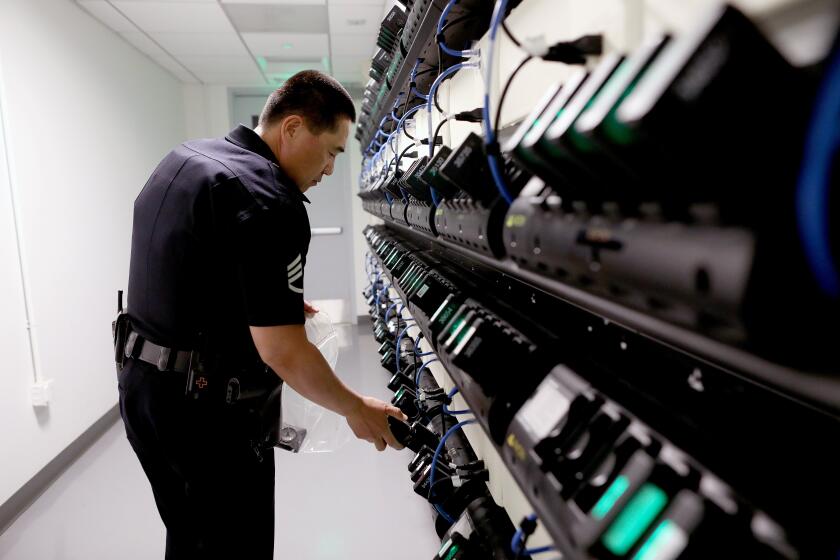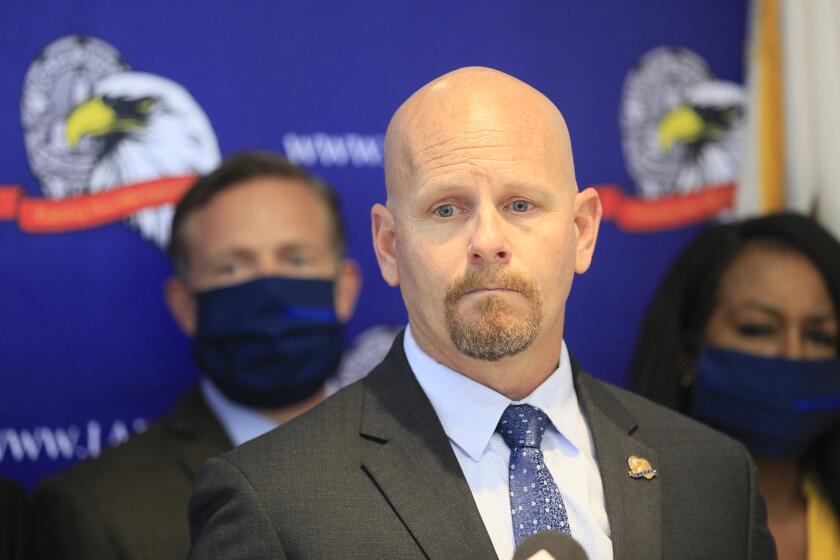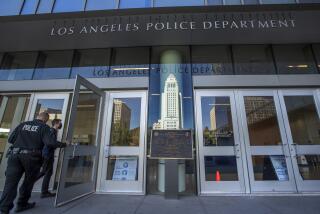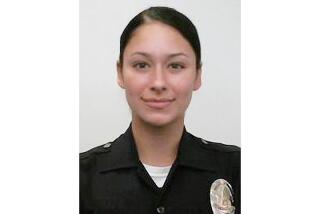Fatal LAPD shooting of mentally ill man who threw objects at vehicles was justified, commission rules
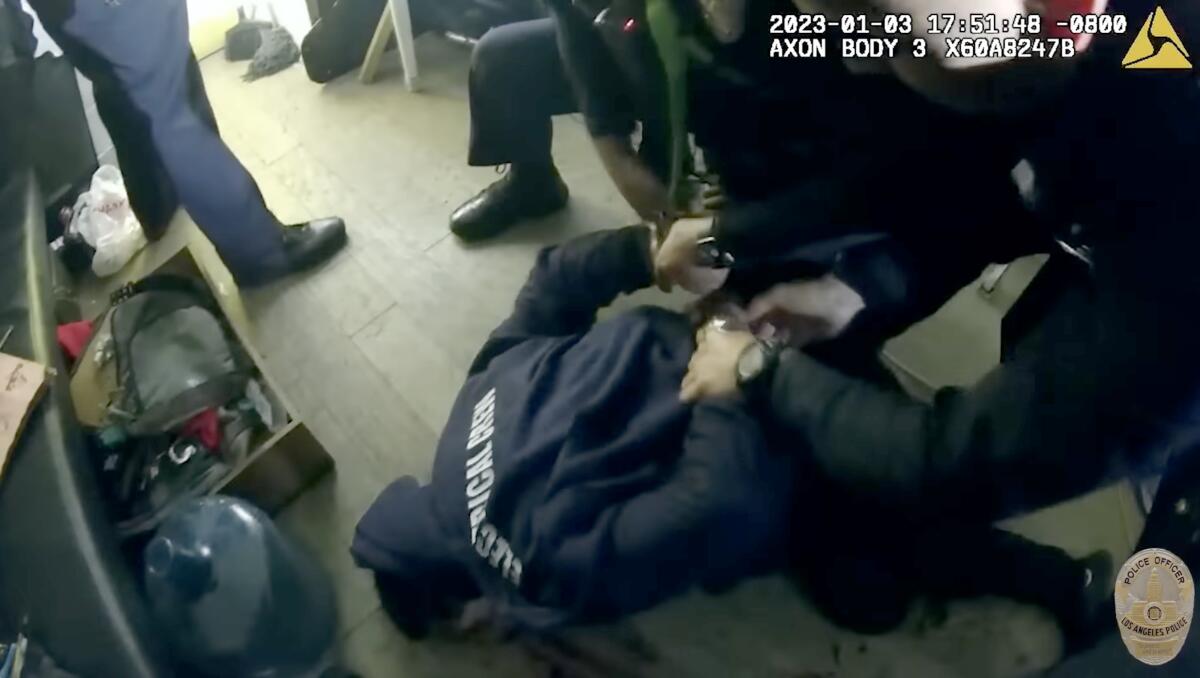
A Los Angeles police oversight body was critical of tactics used by two LAPD officers who fatally shot a mentally ill man holding a scooter part last January, but ultimately ruled that the officers acted within department policy and should not face discipline.
In a 4-0 vote Tuesday, the Board of Police Commissioners agreed with Chief Michel Moore’s findings that Officers Diego Bracamontes and Christopher Guerrero were justified when they opened fire on 35-year-old Oscar Sanchez after responding to multiple 911 calls that he was throwing metal objects at passing vehicles. One commissioner, William Briggs, was absent from the vote.
In a report summarizing the findings of an internal investigation, Moore stopped short of saying that Sanchez’s death could have been averted but questioned some of the officers’ tactical decisions leading up to the shooting, suggesting they missed opportunities to defuse the encounter.
L.A. City Controller Kenneth Mejia released the results of a months-long review of the Air Support Division, questioning ‘whether the LAPD has justified the need for the program’s current size and scope.’
Moore also said the officers should have consulted with the department’s mental health unit before approaching Sanchez. The chief said Sanchez’s decision to forcibly enter a nearby residence — combined with officers’ reasonable belief that he was armed — met the department’s definition of a “barricaded suspect.” Instead of following him inside, Moore said, officers should have retreated and instead summoned the SWAT team and crisis negotiators to the scene.
Sanchez’s death came amid a string of fatal Los Angeles police encounters involving men of color in the throes of mental health crises at the start of the year. In one incident, schoolteacher Keenan Anderson died several hours after an officer stunned him repeatedly with a Taser during an incident in which body-camera footage showed he was running through traffic and yelling incoherently. In another, police shot and killed Takar Smith, a 46-year-old man with schizophrenia who had barricaded himself inside a kitchen after officers ordered him to drop his knife.
The Police Commission ruled there were multiple LAPD policy violations in the deaths of Anderson and Smith. The cases drew protests by activists who said the incidents underscored why armed police are ill-suited for dealing with people in distress.
In the case of Sanchez, the report released Tuesday said officers responded on Jan. 3 to the area of 28th Street and Central Avenue after receiving calls about a man who had wrapped wire from a light pole around a large kitchen knife and thrown objects at passing vehicles. They tried to speak with Sanchez, but he disappeared into a second-story unit of a nearby building. A witness later told police that Sanchez lived there with another person, whose name and relationship to him were redacted from the report.
The officers said they left without detaining Sanchez because they couldn’t locate a victim and concluded that his “demeanor” suggested that any attempts to engage him would lead to use of force. They were dispatched back to the location about half an hour later when another 911 caller reported a man matching Sanchez’s description had thrown something at his vehicle.
Sanchez again ignored the officers’ commands, in Spanish and English, and walked back up to the second-story unit. Pacing back and forth on a landing outside, he complained in Spanish about the flashlights being shined on him and yelled, “You’re not going to rob me, idiot.”
In the wake of a gang unit scandal and concerns about officers misconduct, LAPD leaders are considering whether to use artificial intelligence to analyze vast troves of officer body-cam footage.
Sanchez began trying to force his way into the unit, prompting a supervisor on the scene, Sgt. Edward Asawesna, to order officers to go in after Sanchez if he managed to get inside. The shooting occurred as officers entered the unit, with Bracamontes and Guerrero each firing three rounds. Almost simultaneously, another officer, Carlos Manzo, shot at Sanchez with a projectile from a 40mm “less lethal” launcher used by police to subdue suspects; it’s unclear whether that round struck him.
Sanchez was pronounced dead at the scene.
Bracamontes said in an interview with department investigators that Sanchez was holding what appeared to him to be a “harpoon gun” or a homemade spear with a sharp point, and in what Bracamontes described as a fighting stance.
Asawesna said he didn’t see any weapons in Sanchez’s hand, according to the chief’s report. Moore was critical of Asawesna’s actions at times during the incident, agreeing with a department force review board in that the sergeant exhibited poor judgment in ordering officers to follow Sanchez onto the narrow landing where they had “limited redeployment options.”
Moore said he was pleased with the initial tactics employed by Bracamontes and Guerrero, pointing out that they discussed the nature of the call while en route, as officers were trained to do, and conceived a plan before approaching Sanchez. Sgt. Asawesna, he notes, also ensured that all officers present were assigned proper roles.
But Moore agreed with a majority of the review board, which faulted Bracamontes and Guerrero for failing to recognize this as a barricaded suspect situation. As seasoned officers, they should have known to fall back and call for backup, he said.
The Los Angeles Protective League’s Jamie McBride wrote a recent column in the union’s monthly newsletter accusing the department of lowering its standards on beards and hair.
A minority of the board pointed out that officers often respond to radio calls with only vague information to go on, and that disobeying Asawesna’s orders to pursue Sanchez into the building could have been grounds for insubordination.
Earlier this year, Sanchez’s family filed a wrongful death lawsuit against the two officers and the city, contending that officers had no cause to confront Sanchez when he was going into his home and posed no threat to them or anyone else.
“It’s not clear how they could find that an officer’s use of deadly force was justified in the case when they find that a man was unarmed, that a man was mentally ill and the man was in his own home,” said attorney Christian Contreras, who filed the suit on behalf of Sanchez’s family. “But again it’s not a surprise when this is essentially the police policing themselves.”
Contreras said that Sanchez’s family is still grieving and that the shooting could have been prevented if the officers hadn’t “agitated” Sanchez and escalated the confrontation. The city has denied any wrongdoing in the civil case, which is set to go to trial in February 2025.
Bracamontes was involved in another fatal on-duty shooting at the Ford Hotel on July 20, when he and another officer opened fire on a 56-year-old Black man named Billy Stribling who police said raised a knife over his head as he advanced toward the officers. Stribling was also struggling with mental illness.
The commission’s ruling on the Sanchez case comes amid an ongoing debate about the role police should play in responding to emergency calls involving people suffering from mental illness. Activists have argued that alternative mental health providers would be better equipped to respond to certain calls for help. LAPD officials have agreed in the past but maintained that incidents in which a weapon is present necessitate an armed response.
The department has sought to expand coverage of its Mental Evaluation Unit — which pairs officers with county social workers trained in de-escalating standoffs with people thought to be mentally ill — but officials have said a shortage of clinicians has made this difficult.
A separate mobile response team that is made up entirely of unarmed mental health workers continues to expand, most recently to several neighborhoods in the San Fernando Valley. Proponents have long argued that such programs, and more community-led efforts, remain underfunded.
More to Read
Sign up for Essential California
The most important California stories and recommendations in your inbox every morning.
You may occasionally receive promotional content from the Los Angeles Times.

